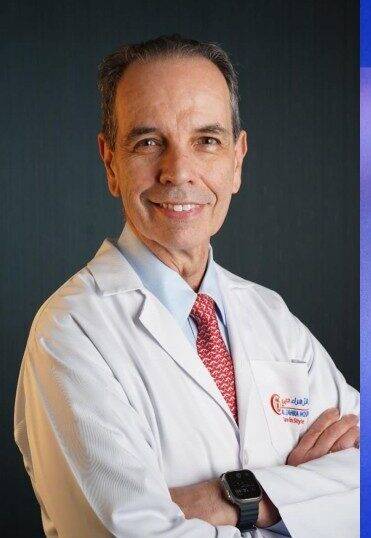Dr Peter Baptista is an ENT Specialist and a leading expert in the field of Sleep Medicine. While working in Spain, he pioneered treatments for obstructive sleep apnea, such as the first robotic transoral surgery and first hypoglossal nerve stimulation series in the country. Dr Peter is European board certified in Otorhinolaryngology, a member of the American Academy of Otolaryngology, Head and Neck Surgery, and the European Sleep Research Society. In April 2022, Dr Peter relocated to Al Zahra Hospital Dubai, bringing his extensive skills and experience to benefit patients in the UAE and the wider region.
At Allocation Assist, we like to keep in touch with our doctors after they move to the UAE. We are always excited to hear about their experiences and achievements.
Dr. Peter, thank you so much for making time to talk about your expertise and relocation experience. Can you start with your career before coming to Dubai?
I was born and grew up in Venezuela, South America. My parents, who are of British and Portuguese heritage, moved to Venezuela after World War II, when the country was undergoing an economic boom. After completing medical school in Caracas, I underwent specialist training at the University Hospital in Navarra (Clinica Universidad de Navarra) in Spain. I then returned to Caracas, where I worked at the University Hospital there and also built up my private practice in ENT Head and Neck Surgery for 11 years.
During this time, I did a lot of endoscopic sinus surgery, and I also started treatment for sleep apnea. I was able to attend courses in the USA regularly, as Miami was only a few hours away by flight. In 2004, I received a call from the University Hospital in Spain, where I had trained, inviting me to take up a consultant post there. We decided to move back to Spain as a family. It was in Spain that I further developed my practice of obstructive sleep apnea surgery. I also attended courses at Stanford University in the USA.
At the University Hospital in Navarra, we established a centre of excellence for sleep apnea, training other surgeons, especially for endoscopic sinus surgery. I have a passion for teaching and still regularly chair courses on sleep apnea in Spain, as well as speaking at international conferences.
Why did you decide to specialise in the management of sleep apnea?
Sleep-disordered breathing has a high prevalence and is often not well understood. Many patients do not realise that they have obstructive sleep apnea, and it can be dismissed as ‘just snoring.’ If left untreated, this condition can lead to increased blood pressure, high blood sugar and high cholesterol levels, known as metabolic syndrome. This increases the risk of heart disease, stroke and type 2 diabetes. Symptoms of sleep apnea include loud snoring, waking up gasping for air, insomnia, daytime tiredness (hypersomnia), mood changes, ‘morning cloudiness’ or headaches. There are many potential causes of sleep apnea.
Patients who are obese, especially with excess fat around the neck, are more at risk. It is important that those with sleep apnea are aware of the condition and have access to the right treatment. The first-line treatment is often the use of a CPAP (continuous positive airway pressure) machine during sleep. But when this is not sufficient, then surgery may be considered.
We even see sleep-disordered breathing in children. Snoring is not normal for children and therefore should not be ignored. If a child is a mouth-breather, for example due to enlarged adenoids and tonsils, this can lead to developmental changes, as the mandibular grows downwards, the midface grows backwards and the neck moves forward. If left untreated, this results in permanent changes in the face. I also see a lot of tongue-ties in both children and adults here. Tongue-tie affects a child’s developmental progress and can have lasting consequences when left untreated.
You are continually seeking to improve patient outcomes, including using innovative surgical techniques. Can you tell us about some of these?
Yes. I have a strong interest in research and innovation. I did my robotic surgery training in Spain, and after the hospital, there was a robotic surgery system. In 2010, I was the first in Spain to do transoral robotic surgery for sleep apnea. However, we found that robotic surgery is not suitable for all sleep apnea cases. I started looking into new techniques, such as hypoglossal nerve stimulation.
I was the first in Spain to introduce hypoglossal nerve stimulation. This procedure involves implanting a small device, similar to a pacemaker. The device also incorporates a breathing sensor and produces an electrical pulse, when required, that stimulates the hypoglossal nerve, causing the tongue muscles to contract so that the tongue moves forward, opening the airway and enabling normal breathing. Hypoglossal nerve stimulation has good success rates when used in the right patients. I hope to introduce this procedure to Dubai in the future.
One challenge is that the technology is expensive, and the procedure may not be covered by insurance. As with any surgery, it is important to carefully select the best technique for each case as well as explain the options to patients. With sleep apnea, we must first investigate the cause of snoring and any obstruction. For this, I perform a diagnostic drug-induced sleep endoscopy.
This procedure involves giving sedation to induce a light sleep, as close as possible to natural sleep, and then using an endoscope to investigate where any obstruction of the airway is occurring. Also, for chronic sinusitis, I regularly perform minimally invasive balloon sinuplasty in addition to endoscopic sinus surgery.
Why did you move to Dubai, and how have you found the experience?
The healthcare sector in the UAE has undergone remarkable growth and development in recent decades. There was an opportunity to bring my skills and experience here to help build up the ENT department, especially in the area of sleep apnea. Another main motivation was for my family.
As I mentioned, I have 3 daughters who are now pursuing university studies. In Spain, doctors’ salaries are among the lowest in Europe, and it was not possible to build up savings for the family due to the high cost of living. Apart from the ability to earn more in the UAE, there is no income tax here. I enjoy working at Al Zahra Hospital. The hospital is very well equipped, with highly experienced doctors and other healthcare professionals from around the world.
My patients also come from a wide variety of nationalities and ethnicities, which makes my practice more interesting. I always spend time with patients, helping them to understand their health problems and carefully explaining treatment options as well as preventive management. Patients have a lot of choice in healthcare providers here, but I have been able to establish my patient base here fairly quickly, building up trust and rapport.
How did you manage to build up your practice so quickly after coming to Dubai?
I had previous experience working in private practice, although I had to get used to the new insurance system here. I have found that when you spend time with patients, explain things very well, and are honest with them, they trust you and come back. When starting in a new place, I have found that it is important to make connections with both patients and colleagues and to be available and flexible.
Another thing I have done is ask patients to submit reviews, such as on Google and other sites. This can be helpful for prospective patients searching online. I also set up my own website (https://entspecialistdubai.com/) where I share helpful and informative information and patient testimonials. This helps patients find out about myself and my practice.
Can you tell us about the two books that you recently published?
Yes. I have written and edited two books on sleep apnea. ‘A Patient’s Guide to Obstructive Sleep Apnea Syndrome’ gives a broad overview of obstructive sleep apnea for patients, including symptoms, causes, diagnosis, and treatment. I am also the main editor of ‘Obstructive Sleep Apnea: A Multidisciplinary Approach,’ which has just been published.
This presents the implications of obstructive sleep apnea across a range of medical specialties, including clinical case reviews. This book will be a valuable resource for clinicians to gain a greater understanding of the condition, enabling improved evaluation and management for patients with obstructive sleep-disordered breathing.
A Patient’s Guide to Obstructive Sleep Apnea Syndrome | Springer https://link.springer.com/book/10.1007/978-3-031-38264-2
Obstructive Sleep Apnea: A Multidisciplinary Approach | Springer




